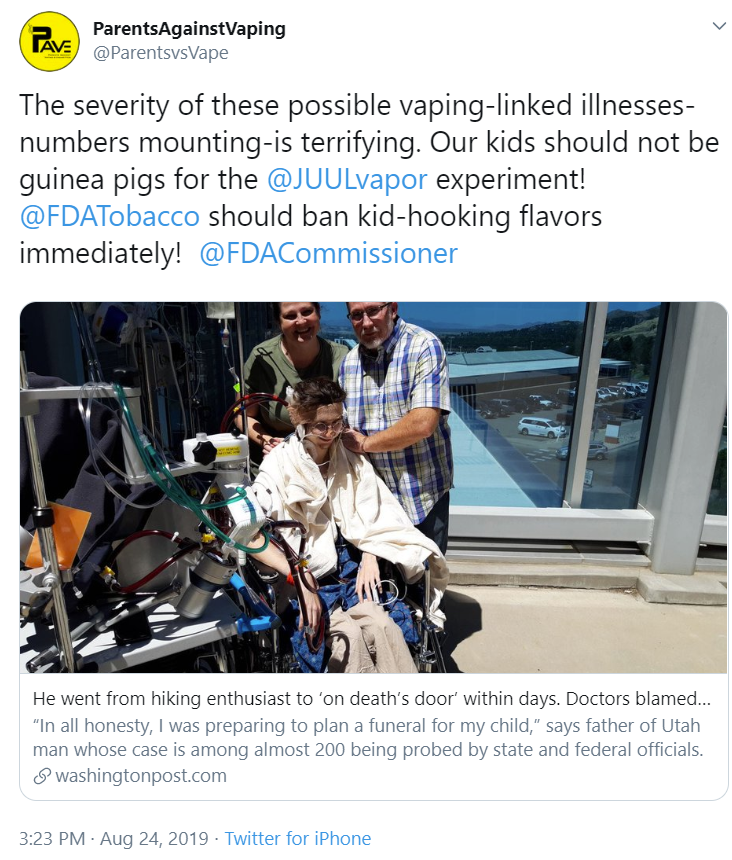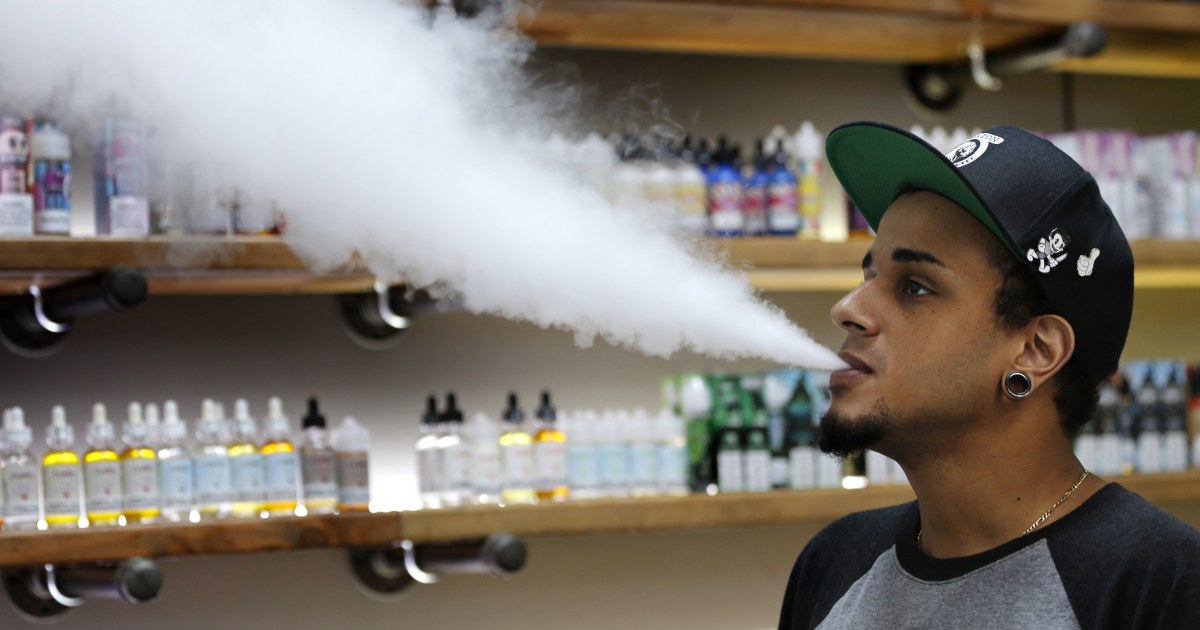
Vaping illnesses and injuries associated with nicotine and chemical exposure may include:
- Asthma
- Brain development issues
- Bronchitis
- Bronchiolitis obliterans (aka Popcorn Lung – caused by exposure to the flavoring chemical diacetyl)
- Heart problems
- Respiratory illnesses
What are the negative health effects of vaping?
The short-term side effects of using nicotine vapes are usually:
- Lingering aftertaste
- Light-headedness
- Sweating
- Headache
- Nausea and vomiting
- High blood pressure
- Increased heart rate
Why are people getting sick from vaping?
Information about the cause of the vaping illness outbreak is limited, however most cases involved illicit products containing THC, the psychoactive ingredient in marijuana. Commercially manufactured e-liquids sold legally in New Jersey contain only nicotine (or may just contain flavoring), but there is an illegal market for THC vape oil. AP
What are the health risks of vaping?
Talk with your kids about the dangers of vaping, but also look for warning signs including:
- Changes in emotions
- Trouble sleeping
- Scents of fruity odors on skin, breath and clothes
- Strange cylinders, chargers or batteries lying around
How is vaping bad for your health?
Vaping and smoking have also been associated with:
- Bad breath
- Bone loss
- Gum disease
- Tooth decay
- Tooth loss

What is vaping illness?
First, let's cover the basics. The condition has been given the term EVALI (e-cigarette or vaping product use-associated lung injury). Whether intentionally or not, it's an acronym that speaks directly to how little is known about the illness; thus far, the only solid link between cases is that those who fell ill reported a history of vaping or e-cigarette use. Sufferers typically report a gradual onset of early symptoms over days or weeks, including respiratory symptoms such as coughing, chest pain, and shortness of breath, as well as nausea, vomiting, diarrhea, fatigue, fever, and weight loss.
How does vaping work?
Beth K. Thielen, University of Minnesota fellow in adult and pediatric infectious diseases, offers a helpful explanation: "With both, the goal of the user is to convert the drug — typically nicotine or THC — into a gas form that can be taken into the body by breathing the drug. With vaping, there is typically a heating element powered by a battery that converts the liquid contents of the vape cartridge into a gas or aerosol. While the way they generate aerosols or gases is different, both smoking and vaping can deliver potentially harmful byproducts in addition to the drug."
What percentage of vaping patients are male?
Of the reported cases where the requisite data is available, the CDC reports that 70 percent of patients are male, 79 percent are under the age of 35, and a full 86 percent report the use of products containing tetrahydrocannabinol, or THC — the main psychoactive compound present in marijuana — suggesting that the chemical plays a marked role in this outbreak.
What is the goal of the user in a drug?
Thielen, University of Minnesota fellow in adult and pediatric infectious diseases, offers a helpful explanation: "With both, the goal of the user is to convert the drug — typically nicotine or THC — into a gas form that can be taken into the body by breathing the drug.
What chemical was found in the first lab test?
In early November, the CDC announced the results of the first lab test in which it had found a common chemical across every sample. That chemical? Vitamin E acetate. From the CDC's statement about the results:
How many states have eli hospitalizations?
Thus far, EVALI has hospitalized patients across 49 states, as well as the District of Columbia and the U.S. Virgin Islands. (As of November 5, Alaska remains the only state that has yet to log a single case.) It has struck patients from ages 13 to 75, with the median age for casualties hovering around 53, even as the median age for an EVALI patient remains at 24.
How many people died from vaping in 2019?
The first smattering of cases were recognized in April 2019. By August, the mysterious illness had claimed its first lives. Months later, with the case count at 2,290 and 47 confirmed deaths, health organizations are scrambling to discover the cause of the vaping-related illness. Much is still unknown about the illness and its causes, ...
What is electronic cigarette?
Commonly referred to as “vaping,” these products use an aerosolized vapor infused with flavors or nicotine that are then inhaled by the user.
How many teens are vaping in 2018?
Health Risks Among Teens. An estimated 3.6 million middle school and high school students reported vaping in 2018, up from 2.1 million the year before. If trends hold steady, that number will continue to rise. Teens and young adults are particularly vulnerable to the effects of vaping products, especially those containing nicotine.
Why do electronic cigarettes explode?
Injuries. Electronic cigarettes use lithium-ion batteries to heat coils and produce an aerosol. On rare occasions, those batteries can malfunction, causing the device to overheat, catch fire, or even explode.
How does an e-cigarette work?
Unlike cigarettes that work by burning to bacco and producing smoke, e-cigarettes heat up liquid to create vapor. A lot of different companies make e-cigarette products, and the kinds of ingredients found in some liquid cartridges can differ from one brand to the next. Some of the most common harmful substances found in vaping products include ...
Is it safe to inhale popcorn?
Some flavor additives, such as diacetyl (found in butter-flavored popcorn) may be safe in small quantities in food but potentially risky to inhale over long periods. Diacetyl has been shown to cause a serious lung disease called “popcorn lung” when inhaled over long periods of time, raising serious concerns among health professionals about its presence in some vaping products.
Is vaping legal in 2020?
As of Feb. 1, 2020, the FDA has banned the manufacture and sale of flavored vaping products (excluding menthol and tobacco). 1 . However, the criteria for product acceptance can still be as loose as it “ does not raise different questions of public health ” compared to an existing tobacco product.
Does vaping affect blood flow?
Another concern flagged by recent research is the potential harm vaping might have on cardiovascular health. Some chemicals found in e-cigs, such as nicotine, can affect blood flow. Studies show that regular use of electronic cigarettes could increase your chances of heart attack, stroke, and even heart disease. In fact, research shows e-cig users are almost twice as likely to experience a heart attack compared to non-users, even when analysts controlled for other known risk factors, including smoking status.
Why are vapes made with THC?
Black market vapes: The reason most of the responsible products contain THC might be because THC vapes are more likely to be doctored than nicotine vapes, particularly in states where marijuana is illegal.
What does it mean when a vape burns hotter?
A higher burn temperature means that chemicals like formaldehyde that form as an ordinary vape operates can be produced more quickly, possibly delivering a dangerous dose.
What flavoring is in vapes?
The flavoring in vapes: Mango and gummy bear vapes are very easy to be concerned about: They appeal to teenagers, and to the already-hard task of figuring out the long-term effects of vaping, they add a whole additional mess of chemicals and reactions.
How many people have died from vaping?
There have been more than 1,600 cases of the mysterious illness that is associated with vaping since May. Thirty-six people have died. The New York Times has a dedicated tracker. What exactly is causing these illnesses and deaths is still unclear, but the Centers for Disease Control and Prevention, which has been trying to assess ...
How many Juul mint pods are contaminated?
Contaminated Juuls: Earlier this year, Juul allegedly shipped 1 million contaminated mint pods, BuzzFeed News revealed this week. The claim comes from a lawsuit filed by a former high-ranking employee. The company told BuzzFeed that there had been a manufacturing issue but denied that this issue led to unsafe pods. The exact alleged contaminant is unspecified.
Is vaping good for you?
Vaping in general: Despite all the warnings to stay away from vapes, this illness is not being caused by vaping at large. Yes, vaping is not good for you. Nicotine isn’t a neutral substance, plus vaping involves inhaling other chemicals with unknown risks.
Is weed cartridge contaminated?
Weed cartridges that are otherwise contaminated: Perhaps otheringredients or contaminants in black market THC vapes are at least partially responsible. In tests commissioned by NBC News, 10 out of 10 bootleg THC vape cartridges contained harmful pesticides. (Though what dose of those pesticides is unclear; they weren’t present in samples of three legit cartridges.)
What is WebMD Connect to Care?
WebMD Connect to Care helps you find services to manage your health. When you purchase any of these services, WebMD may receive a fee. WebMD does not endorse any product, service or treatment referred to on this page. X
How do you know if you have vaping problems?
Symptoms include: Persistent cough. Chest pain. Shortness of breath. Some users may even experience diarrhea, vomiting, nausea and fatigue before any breathing problems develop.
Can vaping cause lung injury?
There are some common symptoms of EVALI, including persistent cough, chest pain, and shortness of breath. As vaping and e-cigarettes have grown in popularity in recent years, so has e-cigarette or vaping product use-associated lung injury (EVALI). Vaping was designed to be addictive.
How many deaths from evali in 2020?
As of February 18, 2020, a total of 2,807 hospitalized EVALI cases or deaths have been reported to CDC from all 50 states, the District of Columbia, and two U.S. territories (Puerto Rico and U.S. Virgin Islands). Sixty-eight deaths have been confirmed in 29 states and the District of Columbia (as of February 18, 2020).
What is vitamin E acetate?
Vitamin E acetate is used as an additive, most notably in THC-containing e-cigarette, or vaping, products. Vitamin E is a vitamin found in many foods, including vegetable oils, cereals, meat, fruits, and vegetables. It is also available as a dietary supplement and in many cosmetic products, like skin creams.
What is the substance in marijuana?
The liquid can contain: nicotine, tetrahydrocannabinol (THC) and cannabinoid (CBD) oils, and other substances, flavorings, and additives. THC is the psychoactive mind-altering compound of marijuana that produces the “high.”
What is an e-cigarette?
Using an e-cigarette is commonly called vaping. E-cigarettes work by heating a liquid to produce an aerosol that users inhale into their lungs.
When did the CDC stop collecting data?
Due to the subsequent identification of the primary cause of EVALI, and the considerable decline in EVALI cases and deaths since a peak in September 2019, CDC stopped collecting these data from states as of February 2020.
How to contact CDC about e-cigarettes?
If you have questions about CDC’s investigation into the lung injuries associated with use of e-cigarette, or vaping, products, contact CDC-INFO or call 1-800-232-4636.
Where to report evali?
CDC encourages clinicians to continue to report possible cases of EVALI to their local or state health department for further investigation.
